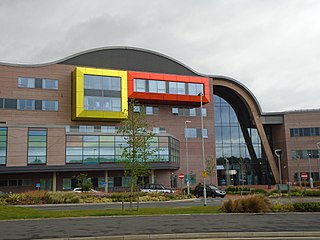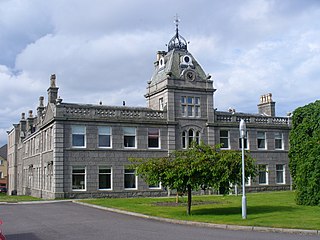Related Research Articles

An emergency department (ED), also known as an accident and emergency department (A&E), emergency room (ER), emergency ward (EW) or casualty department, is a medical treatment facility specializing in emergency medicine, the acute care of patients who present without prior appointment; either by their own means or by that of an ambulance. The emergency department is usually found in a hospital or other primary care center.

Publicly funded healthcare is a form of health care financing designed to meet the cost of all or most healthcare needs from a publicly managed fund. Usually this is under some form of democratic accountability, the right of access to which are set down in rules applying to the whole population contributing to the fund or receiving benefits from it.
A patient is any recipient of health care services that are performed by healthcare professionals. The patient is most often ill or injured and in need of treatment by a physician, nurse, optometrist, dentist, veterinarian, or other health care provider.
General practice is the name given in various nations, such as the United Kingdom, India, Australia, New Zealand and South Africa to the services provided by general practitioners. In some nations, such as the US, similar services may be described as family medicine or primary care. The term Primary Care in the UK may also include services provided by community pharmacy, optometrist, dental surgery and community hearing care providers. The balance of care between primary care and secondary care - which usually refers to hospital based services - varies from place to place, and with time. In many countries there are initiatives to move services out of hospitals into the community, in the expectation that this will save money and be more convenient.
In statistics, the Cuzick–Edwards test is a significance test whose aim is to detect the possible clustering of sub-populations within a clustered or non-uniformly-spread overall population. Possible applications of the test include examining the spatial clustering of childhood leukemia and lymphoma within the general population, given that the general population is spatially clustered.

Woodend Hospital is a health facility located in the Woodend area of Aberdeen, Scotland. It is managed by NHS Grampian.

Alder Hey Children's Hospital is a children's hospital and NHS foundation trust in West Derby, Liverpool, England. It is one of the largest children's hospitals in the United Kingdom, and one of several specialist hospitals within the Liverpool City Region, alongside the Royal Liverpool University Hospital, Liverpool Women's Hospital, Liverpool Heart and Chest Hospital, the Walton Centre, Mersey Regional Burns and Plastic Surgery Unit, and Clatterbridge Cancer Centre.
The Society for Social Medicine (SSM) is the primary organization for researchers in social, community, and public health in the UK and Ireland, founded in London in 1956. The society was renamed the Society for Social Medicine and Population Health. It is affiliated to the European Public Health Association and is a member of the International Epidemiological Association’s European Epidemiology Federation.
A patient-reported outcome (PRO) is a health outcome directly reported by the patient who experienced it. It stands in contrast to an outcome reported by someone else, such as a physician-reported outcome, a nurse-reported outcome, and so on. PRO methods, such as questionnaires, are used in clinical trials or other clinical settings, to help better understand a treatment's efficacy or effectiveness. The use of digitized PROs, or electronic patient-reported outcomes (ePROs), is on the rise in today's health research setting.
Unwarranted variation in health care service delivery refers to medical practice pattern variation that cannot be explained by illness, medical need, or the dictates of evidence-based medicine. It is one of the causes of low value care often ignored by health systems.
Health care quality is a level of value provided by any health care resource, as determined by some measurement. As with quality in other fields, it is an assessment of whether something is good enough and whether it is suitable for its purpose. The goal of health care is to provide medical resources of high quality to all who need them; that is, to ensure good quality of life, cure illnesses when possible, to extend life expectancy, and so on. Researchers use a variety of quality measures to attempt to determine health care quality, including counts of a therapy's reduction or lessening of diseases identified by medical diagnosis, a decrease in the number of risk factors which people have following preventive care, or a survey of health indicators in a population who are accessing certain kinds of care.
Family practitioner committees were established by the National Health Service Re-organisation Act 1973. They replaced local executive councils, which had been established in 1948 to manage primary care.
The NHS Plan 2000 was a ten year plan of the Blair ministry for the National Health Service (England). It combined a commitment to substantial investment with some quite radical changes. The most controversial aspect of the plan was the introduction of more private sector providers and a more competitive internal market. The plan, coming shortly after devolution, marked the beginning of divergence between the NHS in England and NHS Wales. NHS Scotland was legally distinct from England from the beginning of the NHS in 1948.
The King Edward VII Memorial Hospital in Stanley, Falkland Islands is the base for the Falkland Islands Government Health Service.
Population health, a field which focuses on the improvement of the health outcomes for a group of individuals, has been described as consisting of three components: "health outcomes, patterns of health determinants, and policies and interventions". Policies and Interventions define the methods in which health outcomes and patterns of health determinants are implemented. Policies which are helpful "improve the conditions under which people live". Interventions encourage healthy behaviors for individuals or populations through "program elements or strategies designed to produce behavior changes or improve health status".
Prophylactic surgery, is a form of surgery whose purpose is to minimize or prevent the risk of developing cancer in an organ or gland that has yet to develop cancer and is known to be at high risk of developing cancer. This form of preventive healthcare may include surgeries such as mastectomies, oophorectomies, colectomies and surgical corrections, such as the surgical correction of cryptorchidism or undescended testis. Another less common definition of prophylactic surgery also includes the prevention of other diseases, outcomes or even future appearance.

City Hospital is a health facility on Urquhart Road in Aberdeen, Scotland. It is managed by NHS Grampian.

Charles Knight MD FRCP OBE is a British professor of cardiology and chief executive of St Bartholomew's Hospital, part of Barts Health NHS Trust.

The Edinburgh City Hospital was a hospital in Colinton, Edinburgh, opened in 1903 for the treatment of infectious diseases. As the pattern of infectious disease changed, the need for in-patients facilities to treat them diminished. While still remaining the regional centre for infectious disease, in the latter half of the 20th century the hospital facilities diversified with specialist units established for respiratory disease, ear, nose and throat surgery, maxillo-facial surgery, care of the elderly and latterly HIV/AIDS. The hospital closed in 1999 and was redeveloped as residential housing, known as Greenbank Village.
The Institute for the Struggle against the Dangers of Tobacco was set up at the University of Jena in 1942. It was one of the first scientific institutes to discover the dangers of smoking tobacco, including the link between smoking and lung cancer. However, due to its relationship with the ruling Nazi regime, its work was not taken seriously after the Second World War.
References
- 1 2 Harvey, Ian; Jenkins, Rosemary; Llewellyn, Lise (1993). "Enhancing Appropriateness of Acute Bed Use: Role of the Patient Hotel". Journal of Epidemiology and Community Health. 47 (5): 368–372. doi:10.1136/jech.47.5.368. ISSN 0143-005X. JSTOR 25567784. PMC 1059830 . PMID 8289036.
- ↑ Winyard, Graham (1993). "Patient Hotels". Journal of Epidemiology and Community Health. 47 (5): 341. doi:10.1136/jech.47.5.341. ISSN 0143-005X. JSTOR 25567777. PMC 1059823 . PMID 8289029.
- ↑ Groene, O; Lombarts, M J M H; Klazinga, N; Alonso, J; Thompson, A; Sunol, R (2009-02-01). "Is patient-centredness in European hospitals related to existing quality improvement strategies? Analysis of a cross-sectional survey (MARQuIS study)". Quality and Safety in Health Care. 18 (Suppl 1): i44–i50. doi:10.1136/qshc.2008.029397. ISSN 1475-3898. PMC 2629879 . PMID 19188461.
- ↑ Chesterton, L. E.; Stephens, M.; Clark, A. J.; Ahmed, A. (2021-01-31). "A systematic literature review of the patient hotel model" (PDF). Disability and Rehabilitation. 43 (3): 317–323. doi:10.1080/09638288.2019.1628314. ISSN 0963-8288. PMID 31211929. S2CID 195064955.
- 1 2 "Could state-funded patient hotels be the future?". the Guardian. 2013-03-26. Retrieved 2022-07-29.
- 1 2 Quito, Anne (2015-11-12). "In Scandinavia, "patient hotels" provide an alternative to hospitals". Quartz. Retrieved 2022-07-29.
- ↑ "Why trusts should think seriously about patient hotels". Health Service Journal. 17 September 2014. Retrieved 21 October 2014.
- ↑ Seddon, Nick (26 March 2013). "Could state-funded patient hotels be the future?". Guardian. Retrieved 21 October 2014.
- ↑ "NHS bosses ponder hospital hotels to ease ward pressure". BBC News. 23 April 2013. Retrieved 21 October 2014.
- ↑ "About Us". rmhccanada.ca. Canada: Ronald McDonald House Charities. Retrieved 18 April 2017.
- ↑ "Our Core Programs | RMHC". rmhc.org. Retrieved 2022-07-29.